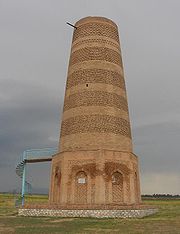- Balasaghun
-
Balasagun
Balasagun (Balassagun, Balasaghun, Karabalsagun ; chinois : 八剌沙衮 ; pinyin : bālàshāgǔn, perse : بلاساغون) est une ancienne ville sogdienne située dans l'actuel Kirghizistan, dans la vallée du fleuve Chu entre Bichkek et le lac Yssyk Koul.
Elle fut fondée par les Sogdiens, un peuple d'origine iranienne dont la langue, le sogdien, était encore parlé dans la région au XIe siècle[1].
Elle fut la capitale des Kara-Khitans du XIIe siècle à sa prise par les Mongols en 1218. Les Mongols l'appelaient Gobalik (jolie ville). Il ne faut toutefois pas confondre cette ville avec celle de Karabalghasun en Mongolie, capitale du khaganat ouïghour.
Balasagun supplanta rapidement Suyab comme principal centre politique et économique de la vallée du fleuve Chu. Sa prospérité déclina cependant après la conquête mongole. Le poète Yusuf Balasaghuni, connu pour avoir écrit le Qutadğu Bilig « La Science qui apporte le bonheur » (1067-1070), serait né à Balasagun au XIe siècle. Ecrit en turc (et non en sogdien), il s'agirait d'un ouvrage « médiocre » selon l'historien Jean-Paul Roux, mais qui « imposa le turc comme troisième langue du monde islamique après l'arabe et le persan, et le sauva peut-être de la complète iranisation en cours tant chez les Ghaznévides que chez les Seldjoukides. » [2]
La ville comptait également une importante population chrétienne nestorienne et un cimetière était encore utilisé dans les années 1300[3].
Depuis le XIVe siècle, Balasagun est un village parsemé en ruines, à 12 km au sud-est de Tokmok. La zone de Burana située en bordure de Tokmok et à 6 km du village actuel constituait l'extrémité ouest de la ville. On y trouve la Tour Burana et un champ de pétroglyphes, les balbal. La Tour Burana est un minaret construit au XIe siècle sur les ruines de la ville. Haute de 24 mètres, elle aurait mesuré 46 mètres à l'origine. Plusieurs séismes au fil des siècles ont causé de nombreux dommages, les monuments actuels étant l'œuvre d'une vague campagne de restauration dans les années 1970.
Références
- ↑ Vassily Bartold, « Balāsāg̲h̲ūn or Balāsaḳūn », Encyclopaedia of Islam, P. Bearman, Th. Bianquis, C. E. Bosworth , E. van Donzel and W. P. Heinrichs, Brill, 2008.
- ↑ Jean-Paul Roux (Directeur de recherche honoraire au CNRS, ancien professeur titulaire de la section d'art islamique à l'École du Louvre), Le premier empire des steppes qui devint musulman : les Karakhanides, avril 2003.
- ↑ W. Klein, « Das nestorianische Christentum an den Handelswegen durch Kyrgyzstan bis zum 14 Jh. », Silk Road Studies III, Brepolis, 2000.
- Portail de la géographie
Catégorie : Ville du Kirghizistan
Wikimedia Foundation. 2010.


